Chemical biology
Bioinorganic chemistry

Bioinorganic chemistry, the study of metal ions and their applications in biological systems, is a highly multidisciplinary field that lies at the crossroads between the physical and life sciences. Although life is traditionally considered ‘organic’ (the elements C, H, N, and O account for over 95% of the mass of a typical human body), metal ions and inorganic materials play vital roles in biology, the environment, and medicine. Approximately 40% of all currently known enzymes contain a metal ion at their active site, and medicinal chemistry is heavily reliant on metal ions in therapeutics such as antibiotics and anticancer agents. Certain bacteria use metal-containing enzymes to extract energy from H2, and to convert atmospheric CO2 into a carbon feedstock for synthesising more complex molecules. Understanding how these processes work and can be exploited is critical.
Bioinorganic chemistry research at the University of Leicester is wide-ranging, providing insight into structure-activity based approaches for developing anticancer metal complexes, probing the interaction of metal complexes with DNA and proteins, assessing the therapeutic potential of metal complexes against cancer cells, developing advanced spectroscopic methods to probe enzyme mechanism, and using electrochemistry and photochemistry to control energy-relevant small molecule activation reactions.